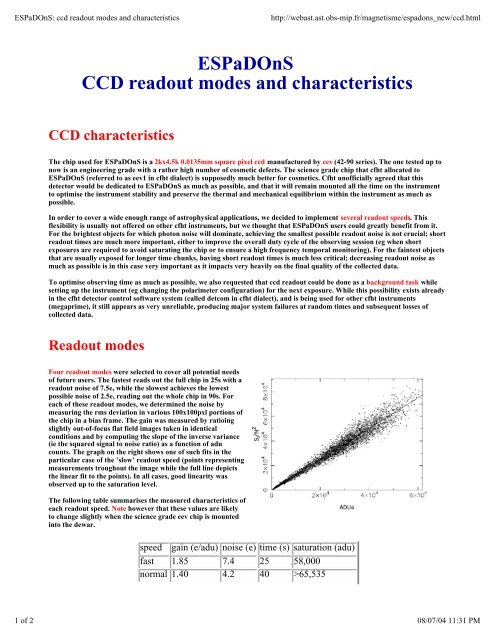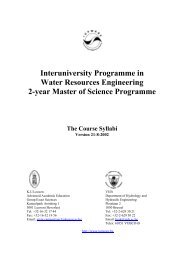CFHT operating manual - Homepage Usask
CFHT operating manual - Homepage Usask
CFHT operating manual - Homepage Usask
You also want an ePaper? Increase the reach of your titles
YUMPU automatically turns print PDFs into web optimized ePapers that Google loves.
ESPaDOnS: ccd readout modes and characteristics http://webast.ast.obs-mip.fr/magnetisme/espadons_new/ccd.html<br />
ESPaDOnS<br />
CCD readout modes and characteristics<br />
CCD characteristics<br />
The chip used for ESPaDOnS is a 2kx4.5k 0.0135mm square pixel ccd manufactured by eev (42-90 series). The one tested up to<br />
now is an engineering grade with a rather high number of cosmetic defects. The science grade chip that cfht allocated to<br />
ESPaDOnS (referred to as eev1 in cfht dialect) is supposedly much better for cosmetics. Cfht unofficially agreed that this<br />
detector would be dedicated to ESPaDOnS as much as possible, and that it will remain mounted all the time on the instrument<br />
to optimise the instrument stability and preserve the thermal and mechanical equilibrium within the instrument as much as<br />
possible.<br />
In order to cover a wide enough range of astrophysical applications, we decided to implement several readout speeds. This<br />
flexibility is usually not offered on other cfht instruments, but we thought that ESPaDOnS users could greatly benefit from it.<br />
For the brightest objects for which photon noise will dominate, achieving the smallest possible readout noise is not crucial; short<br />
readout times are much more important, either to improve the overall duty cycle of the observing session (eg when short<br />
exposures are required to avoid saturating the chip or to ensure a high frequency temporal monitoring). For the faintest objects<br />
that are usually exposed for longer time chunks, having short readout times is much less critical; decreasing readout noise as<br />
much as possible is in this case very important as it impacts very heavily on the final quality of the collected data.<br />
To optimise observing time as much as possible, we also requested that ccd readout could be done as a background task while<br />
setting up the instrument (eg changing the polarimeter configuration) for the next exposure. While this possibility exists already<br />
in the cfht detector control software system (called detcom in cfht dialect), and is being used for other cfht instruments<br />
(megaprime), it still appears as very unreliable, producing major system failures at random times and subsequent losses of<br />
collected data.<br />
Readout modes<br />
Four readout modes were selected to cover all potential needs<br />
of future users. The fastest reads out the full chip in 25s with a<br />
readout noise of 7.5e, while the slowest achieves the lowest<br />
possible noise of 2.5e, reading out the whole chip in 90s. For<br />
each of these readout modes, we determined the noise by<br />
measuring the rms deviation in various 100x100pxl portions of<br />
the chip in a bias frame. The gain was measured by ratioing<br />
slightly out-of-focus flat field images taken in identical<br />
conditions and by computing the slope of the inverse variance<br />
(ie the squared signal to noise ratio) as a function of adu<br />
counts. The graph on the right shows one of such fits in the<br />
particular case of the ’slow’ readout speed (points representing<br />
measurements troughout the image while the full line depicts<br />
the linear fit to the points). In all cases, good linearity was<br />
observed up to the saturation level.<br />
The following table summarises the measured characteristics of<br />
each readout speed. Note however that these values are likely<br />
to change slightly when the science grade eev chip is mounted<br />
into the dewar.<br />
speed gain (e/adu) noise (e) time (s) saturation (adu)<br />
fast 1.85 7.4 25 58,000<br />
normal 1.40 4.2 40 >65,535<br />
1 of 2 08/07/04 11:31 PM

















